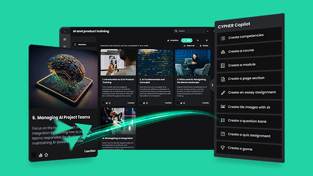Creating goals is not an option but a must if you’re a teacher. You ensure long-lasting results by having a clear view of what you want to achieve in your classroom. The purpose of teaching goes far beyond passing on theoretical knowledge. Today, it’s more important than ever to equip students with future-ready skills they can leverage later in their personal and professional lives.
Establishing SMART learning objectives is the first step you need to take on this journey. These objectives are the “why” behind your actions – the reason why you teach students and engage them in the learning process. How you answer this question is the path to creating smart objectives.
In this article, we will explore the topic of SMART learning objectives in depth. From educational institutions to multinational organizations and training professionals, everyone seems to insist on their importance. We will walk you through the definition of these objectives, their advantages, and how to set and track them within a learning management system (LMS).
What are SMART learning objectives?
SMART learning objectives refer to intended learning outcomes that follow a certain structure. SMART is an acronym for: Specific, Measurable, Achievable, Relevant and Time-Bound.
These are the five features that characterize a SMART objective. Their purpose is to shape a solid framework that helps you establish and meet realistic goals. Let’s dig deeper into the five traits that shape SMART learning objectives:
- Specific: refers to how concrete your goals are; the more specific, the better. For example, helping students achieve good grades is not specific. The definition of good grades is vague and subjective. Helping all the students in your class get Bs and above on the final test is a specific goal;
- Measurable: you can’t know if you’ve reached your destination if you don’t have a clear location. As a teacher, you have different tools and methods for measuring student success. Grades, progress in classes and feedback forms are just two examples;
- Achievable: it’s important to have a realistic approach while setting smart learning objectives. Expecting all the students in your class to get straight As is more than likely an unattainable goal. A SMART objective can be accomplished in normal circumstances when it comes to skills, resources and teaching context;
- Relevant: naturally, you want your students to learn something useful from your courses. Hence, you must set relevant goals so students can learn the right things at the right time and later apply the knowledge in real-life situations;
- Time-bound: as a teacher, you are already used to deadlines. The same applies to your students’ goals. To motivate students and ensure a steady pace for the whole learning process, the goals you establish have to be time-bound. However, when it comes to personalized learning, the time it takes to master a skill can also be different for each student.
Examples of SMART learning objectives
There are a few steps to take to write SMART learning objectives and they come down to answering a few simple questions:
- What do you want your students to accomplish?
- What steps do they have to take to accomplish the learning goal (e.g. complete a module within the LMS, submit a written assignment, take a quiz, etc.)?
- How are you going to measure the results (grades, pass/failed status, number of points, etc.)
Writing effective learning objectives is easy once you know what a SMART objective looks like. Therefore, the fastest way is to take a look at SMART learning objectives examples for teachers and students:
- By June 2022, I will be able to easily set smart objectives for my lessons and each lesson will have at least three objectives I will also track in my LMS;
- By April 10th, my students complete two quizzes in the LMS and hand in one written assignment;
- By April 15th, I will grade the written assignments and run a quiz results report from the LMS to have a clear overview of my students’ performance;
- I will create and upload two more classes on different topics in the learning platform this semester;
- By the end of the semester, my students will achieve the minimum mastery level required for each competency.
Goals such as the above are measurable, relevant to your activity, and subject to a deadline. They are SMART goals you and your students can achieve by establishing and sticking to a plan.
These learning objectives will help you make your lessons more engaging as students will have a clearer understanding of where they are and where they need to be. You’ll also be able to present them for each class and lesson so students will know what they’re working towards. Finally, SMART goals will help you continuously optimize and improve your teaching and assessment.
Let’s move forward and see how you can configure them in an LMS.
Use SMART learning objectives in an LMS through competency-based learning
Competency-based learning is one of the most valuable LMS features. This type of learning requires learners to demonstrate concrete and measurable skills. In an LMS, teachers can assign certain competencies to each class. Those competencies are the skills students must prove they’ve acquired in order to complete a class or even a learning path.
To demonstrate mastery, students have to pass certain tests, complete assignments and go through their lessons. Depending on the settings that you choose, they cannot advance from one lesson or section to the next until they achieve skill mastery. Competency-based learning ensures a gradual, structured advancement through the class and constantly helps you track student understanding.
This is also where each student can work on a certain competency at their own pace, so maybe it will take them a few more days to master a certain skill, but you’ll know that they’ve achieved mastery and are not advancing to the next lesson with an incomplete understanding of the previous one.
Use competency-based learning features to add SMART learning objectives
All of the above might seem complicated, but they aren’t. On the contrary, the whole process is automated. The LMS allows students to advance through a class as they achieve mastery and tracks their progress.
Here are the main steps you need to take to create a SMART goal in an LMS with the help of competency-based learning features:
1. Upload or create competencies related to your SMART learning objectives
You can upload or build different competencies in the LMS and add more than one set of competencies to a class. Some LMSs already offer a set of built-in curriculum standards such as US Common Core Standards.
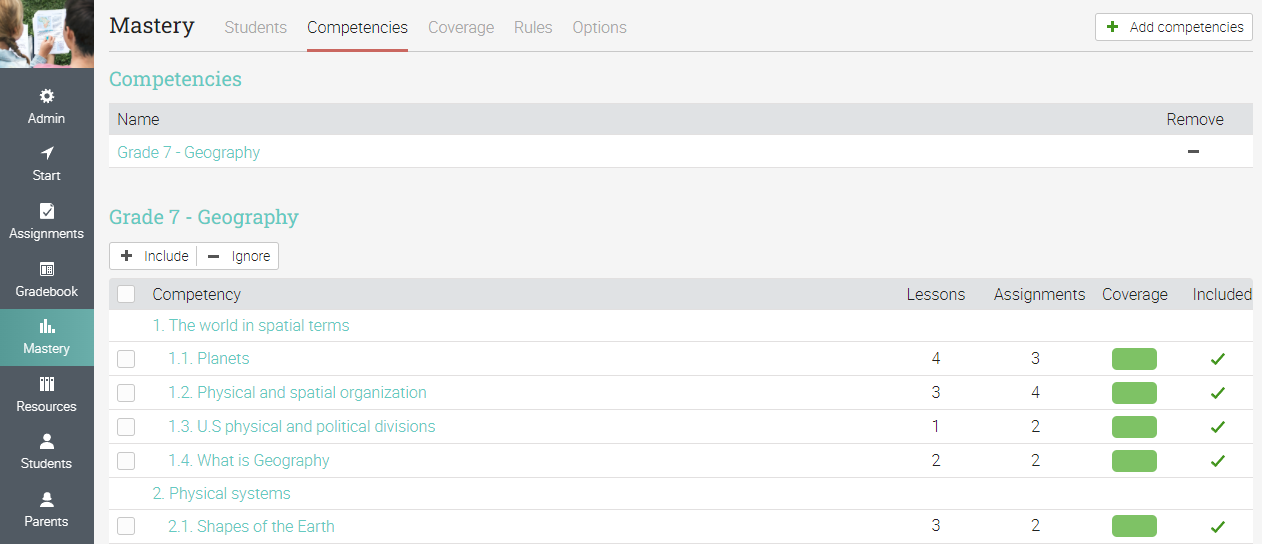 Create or upload SMART learning objectives.
Create or upload SMART learning objectives.
2. Tag lessons and assignments with competencies
After the competencies are uploaded, you have to tag each lesson or section with the skills it will teach and each assignment with those it will assess.
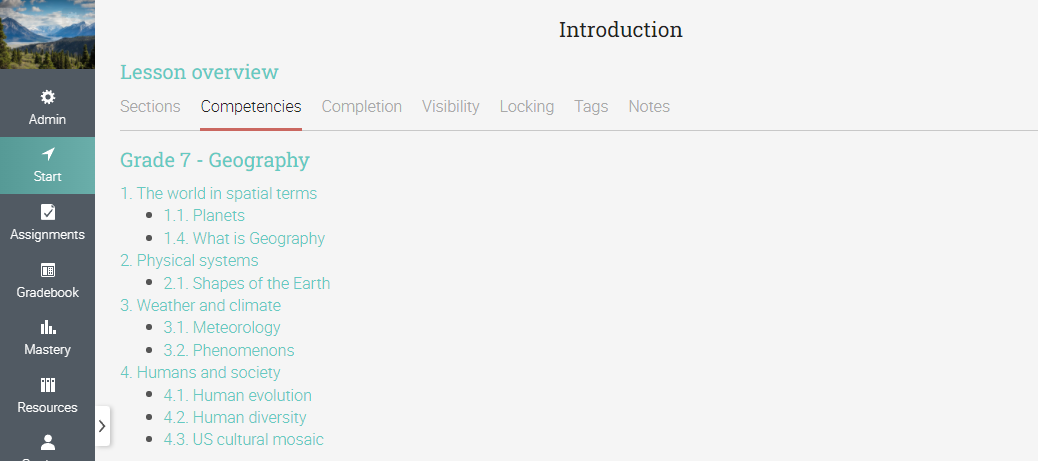 Tag lessons and assignments with related competencies.
Tag lessons and assignments with related competencies.
3. Automate the competency-tracking process
As students complete their classes and related assignments, there are certain actions you can automate from the LMS to support them in achieving mastery.
For example, if a student is stuck between a 40 and 50% competency level, you can set up a rule to automatically send them a notification with additional resources. Plus, you can also show them an additional assignment that is easier to achieve so scaffolding is in a way also automated. This will help them improve their skills, reach mastery, and therefore meet their SMART goals.
![]() Adding rules to competency-based learning allows teachers to automate the learning objective tracking process.
Adding rules to competency-based learning allows teachers to automate the learning objective tracking process.
Read more: Why each student needs a personalized learning path
4. Track student progress
For each competency you add to a lesson, the platform can show you an overview of how each student is doing within an intuitive mastery grid. The achievement level can be expressed in percentages next to each person’s name. So you will easily see where each student struggles and will be able to step in and help.
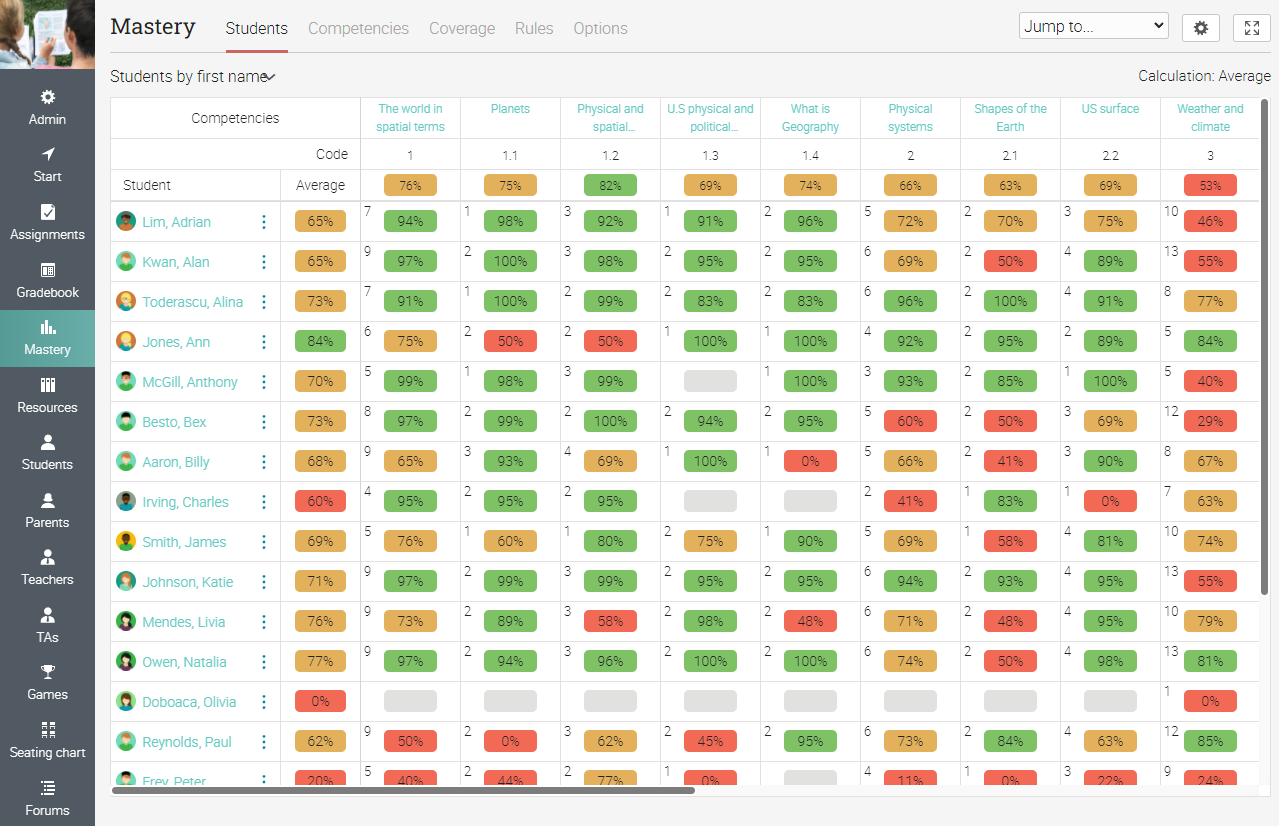 See how students are doing on each learning objective.
See how students are doing on each learning objective.
5. Mastery coverage
You can also see how well your content covers the assigned competencies, identify and fix issues by improving the assessment or the lesson’s content to fill in possible gaps.
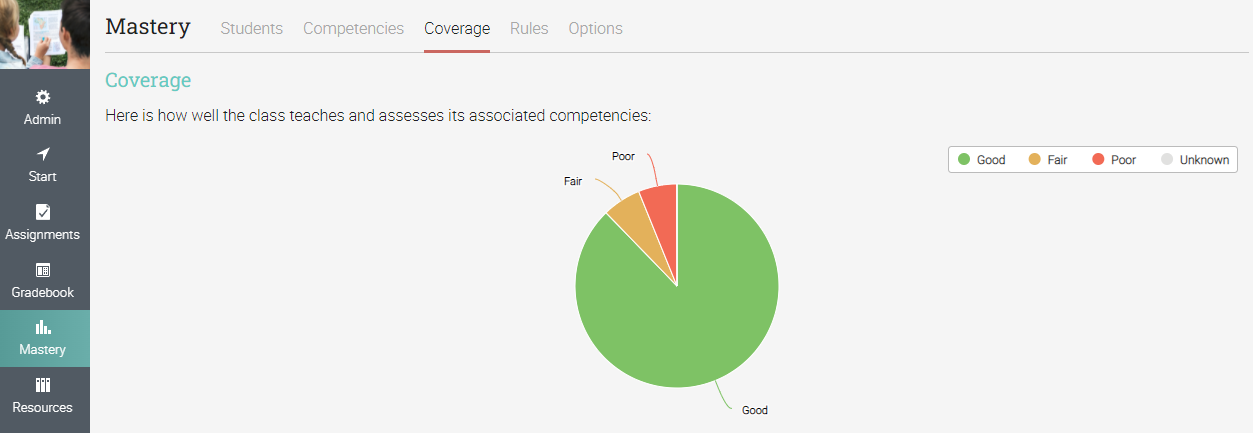 See how well your class covers the learning objectives.
See how well your class covers the learning objectives.
Read more: The 6 principles of mastery-based learning
SMART learning goals: an LMS example
The competencies you create in an LMS are directly correlated with your SMART learning objectives. So you can easily monitor their progress in the LMS to make sure everyone in your class accomplishes their class-related goals.
The lessons and competencies
Here is an example of smart learning objectives transposed in an LMS through competency-based learning features.
Let’s imagine you’re a university teacher who teaches Spanish for international students. Your purpose is to help students successfully pass their final Spanish exam. So this is your smart, measurable goal. To achieve it, you add a set of competencies in your LMS to each grammar lesson students have to complete in the platform:
- A lesson that focuses on nouns: correctly identifying and using definite articles and genders;
- A lesson that focuses on the Present Tense: recognizing and using the correct verb terminations for regular verbs;
- A lesson that focuses on the verb “to be” in Spanish: making the difference between the verbs “ser” and “estar” and being able to use them in appropriate contexts.
All these competencies should be accompanied by quizzes or written assignments that give students the chance to prove their mastery and a deadline for each lesson and assignment.
The goal tracking process
After tagging the lessons and assessments in the LMS with the relevant competencies, the goal tracking process will be easy to understand if each lesson meets its intended learning outcomes. For example, a lesson that offers a comprehensive overview of Spanish articles but lacks any assignment at the end is incomplete. Hence, to improve it and make it blend in with your SMART approach, you need to add a quiz at the end.
After optimizing your lessons so they ensure a solid mastery level, the student evaluation part begins. This is done automatically as learners go through your lessons and complete each assignment.
By tracking students’ mastery levels, you can easily spot those who face difficulties. LMSs display student progress and completed objectives at-a-glance (through graphs, tables, or charts). This information will enable you to intervene by helping slow-working students who need more support.
When all the students in your class achieve the minimum mastery level in the LMS, their SMART goal is accomplished as they are ready to pass their final exam successfully.
Furthermore, you can even convert the score or level students achieved in the LMS into a grade. Hence, consider the exam completed based on this correspondence without having students take a written exam.
The bottom line
SMART learning objectives are highly efficient for any type of class. These features make it easy to apply a step-by-step plan to achieve them and stick to it.
With an LMS, this path is already configured thanks to competency-based learning features. Teachers can leverage these features to easily establish and track SMART goals and ensure all their students acquire the minimum level of mastery of particular skills.
